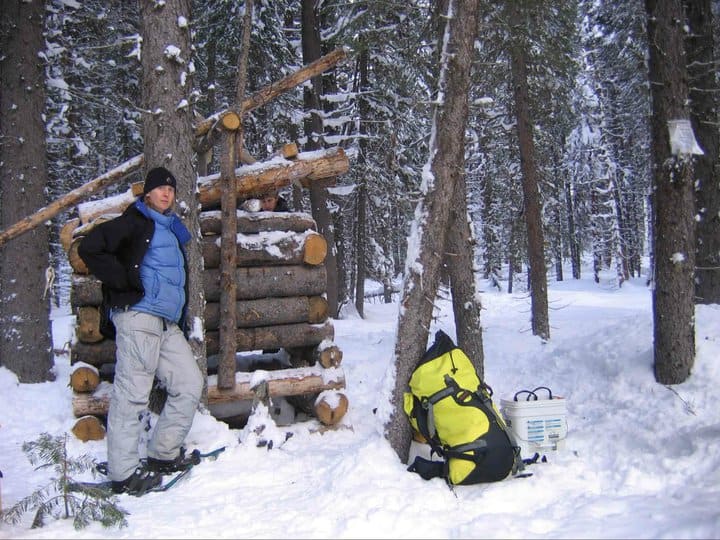Gear and Tips for Cold Climate Winter Wildlife Work
By: Kris Boyd
Hi. My name is Kris and I grew up in Los Angeles. There it is in black and white. I tell you this so that it is no surprise to you that my learning curve about winter wildlife work was steep… very steep… ludicrously steep now that I look back on it. And I tell you this so that you can be assured that the tips I’m going to give you aren’t a re-hashing of internet memes – they’ve been earned through sweat and blood and, yes, tears.
Tears. Winter work in cold climates can be intense and taxing, particularly if you are not accustomed to true cold, or being out in it for hours on end. Cold is painful, and pain can be frightening. For the uninitiated this can be mentally and physically exhausting. So my first tip for all you first-time winter wildlifers is to be as forgiving and honest with yourself and your boss as possible while you adjust to this new way of working. Bring a few extra hand and foot warmers with you. Pay the extra money for the down mittens and well-insulated boots. Get yourself a good thermos and a can of hot chocolate mix. And give yourself some good sleep.
Did I mention winter work can be taxing? Yes. And nutrition and hydration are paramount in winter to keep your body warm. Drink lots of water… then drink some more! Cold air is dry and sucks moisture from your body with every breath. If your body is dehydrated your circulation will be reduced, the blood vessels in your extremities will constrict, and you will become more susceptible to frostbite. Eat lots of food… then eat some more! At every meal, eat lots of calorie dense foods that are high in protein and healthy fats. Throw a tablespoon of your favorite oil into your morning’s hot cereal or your thermos of hot chocolate. Slather that whole-grain bread with twice as much nut butter. Savor that extra dark chocolate bar in the afternoon. Make that hasty dinner before collapsing into bed a 5-egg omelet stuffed with 5 servings of veggies!
Why do I push the nutrition aspect above cool winter gear, you may ask? Because safe winter work starts from the inside out. No amount of high-tech insulation can warm a malnourished body. In the same vein, no amount of high-tech insulation can warm a technician wearing cotton underbritches. COTTON KILLS (in winter).
Keeping your skin dry is the most important aspect of staying warm in cold temperatures. During active winter work, even in the pouring rain, sweat is usually the biggest contributor to chills. Cotton fiber does not wick sweat away from your body and allow your skin to stay dry and warm, which is why even 20% cotton underbritches are not a good choice. Fibers such as rayon, modal, viscose, bamboo, tencell, and lyocell should also be avoided as they too absorb rather than wick water. In all your layers from socks to soft shells look for fabrics made from polyester, nylon, or wool.
When it comes to outer layers, save your good stuff (if you have any) for the ski slopes. Winter work will take a toll on your pants and jackets, so look online or in-person for some great deals that won’t leave you crying when that live trap rips your jacket pocket open or your pants smell like gasoline-soaked roadkill. You can find good deals on new gear on websites such as Campmor (campmor.com), Sierra Trading Post (sierratradingpost.com), REI Garage (rei.com/rei-garage), Steep & Cheap (steepandcheap.com), and on membership websites such as The Clymb (theclymb.com) or Promotive (promotive.com). Used gear is also a great option from sites such as Gear Trade (geartrade.com), Mountain Equipment Recyclers (merecyclers.com), Craigs List (craigslist.org), and Ebay (ebay.com). And if you’re in it for the long haul, a purchase made from Patagonia can last you a lifetime, as they do free repairs on all their clothing for the lifetime of the garment. Of course there are always good finds, including “Patagucci” gear, at garage sales and used clothing or sporting goods stores, especially in towns that tend toward higher income households.
But be warned! Just because I suggest looking for deals on gear doesn’t mean it should be treated cheaply. Dirt and sweat damages the water resistance of your outerwear and the loftiness and knapp of your baselayers that keep you warm and dry. As much as possible, keep your clothes and boots clean and dry when not in the field. A boot dryer (both electric and propane versions are available) will extend the life of your winter boots and boot liners dramatically, as well as ensure you start the day happy with dry feet. And don’t be afraid to re-apply waterproofing to your gear – after you’ve gotten the dirt off!
Finally, for your sake and the sake of your co-workers, be prepared for mishaps in the field. Pack a first aid kit that includes a small LED headlamp, fire starter, matches, a couple hand and foot warmers, a space blanket, a multi-tool, blood clotter, gauze, duct tape, p-cord, a handful of those thin plastic produce bags, and a couple of your favorite energy bars. If you can get your hands on a lightweight dry bag, store everything in there. If not, a freezer-weight plastic bag will work for a few weeks until it needs replacing again.
Take care of yourself and have fun out there!



